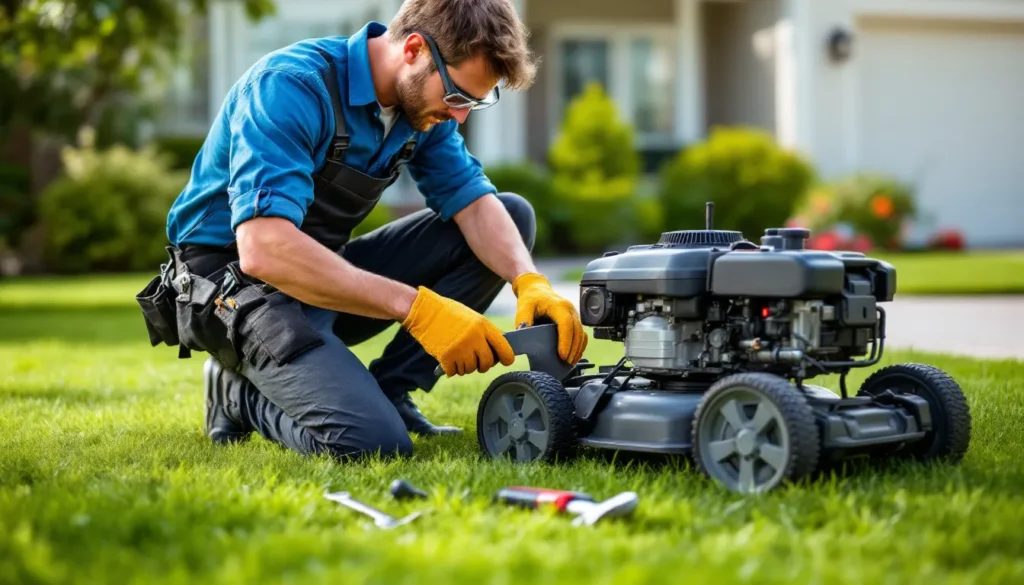If you want a lush green lawn, keeping your mower in top shape is essential. One of the most important maintenance tasks is changing the mower blade. A sharp blade not only cuts grass cleanly but also promotes healthier growth. Neglecting this task can lead to uneven cuts and stress on your lawn.
Tools You Will Need
Changing a lawn mower blade requires specific tools and safety equipment to ensure efficiency and safety. Below are the essential tools and safety gear needed for this task.
Essential Tools
- Wrench: A socket wrench or adjustable wrench is crucial for loosening and tightening bolts on the blade.
- Screwdriver: A flathead or Phillips screwdriver may help remove any screws securing the blade.
- Replacement Blade: Always use a compatible replacement blade designed for your mower model.
- Cutting Board or Work Surface: A stable surface eases the blade removal and installation process.
- Grease: Lubricating the spindle can enhance performance and extend the lifespan of your mower.
- Rags: Use rags for cleaning grease and debris from the mower.
Safety Equipment
- Work Gloves: Wear durable work gloves to protect your hands from sharp edges and debris.
- Safety Glasses: Protect your eyes from flying debris while working on the mower.
- Closed-Toe Shoes: Choose sturdy shoes that cover your feet entirely for added protection.
- Ear Protection: If your mower is particularly loud, earplugs or earmuffs will reduce noise exposure.
Preparing Your Lawn Mower

Preparing your lawn mower ensures a safe and efficient blade change. Follow these steps to get your mower ready.
Disconnecting the Spark Plug
Disconnecting the spark plug prevents accidental starts during blade replacement. Locate the spark plug wire on the engine, pull it away from the plug, and ensure it’s secure. This step minimizes the risk of injury while working on the mower.
Cleaning the Mower Deck
Cleaning the mower deck removes grass clippings and debris that can hinder performance. Use a scraper or brush to clear buildup, focusing on the underside of the deck. Ensure a clean surface to promote proper blade operation and extend mower life.
Removing the Old Blade
Removing the old blade is a crucial step in maintaining your lawn mower’s efficiency. Follow these straightforward steps to ensure a safe and effective blade removal process.
Loosening the Blade Bolt
- Position the mower: Ensure the mower is on a stable and flat surface. This prevents slipping during the process.
- Wear gloves: Protect your hands while handling the blade and tools.
- Locate the blade bolt: Identify the central bolt securing the blade. It’s usually located at the center of the mowing deck.
- Use a wrench: Fit the wrench onto the blade bolt. Turn it counterclockwise to loosen the bolt. Apply steady pressure to avoid stripping the bolt.
- Stabilize the blade: Place a block of wood or similar object against the blade to prevent it from rotating while loosening the bolt.
Taking off the Old Blade
- Remove the bolt completely: After loosening, continue turning the bolt until it completely detaches from the blade.
- Lift the blade: Carefully lift the blade off the spindle. Ensure you don’t drop it, which could cause injury or damage.
- Inspect the old blade: Examine the old blade for signs of wear or damage. Identifying issues can help prevent future problems.
- Clean the spindle: Wipe down the spindle area with a rag to remove any debris or grass clippings. This ensures a clean surface for the new blade attachment.
Following these steps ensures a proper removal of the lawn mower blade, setting you up for an efficient replacement.
Installing the New Blade
Installing the new blade requires careful attention to detail to ensure optimal mower performance. Follow these steps for a seamless installation process.
Aligning the New Blade
Align the new blade with the spindle. The blade features a center hole that fits over the spindle, and blades often have specific markings indicating the correct orientation. Ensure that the cutting edge of the blade faces the direction of mower movement for efficient cutting. Position the blade securely on the spindle, and confirm that it rests flatly against the mounting area. Take time to verify proper alignment to prevent improper cutting and potential damage to the mower.
Tightening the Blade Bolt
Tighten the blade bolt securely to prevent the blade from loosening during operation. Use the wrench to fasten the bolt, ensuring it’s snug but not overly tight to avoid stripping threads. A torque specification might exist for your specific mower model; consult the owner’s manual for exact figures. Hold the blade in place while you apply pressure to the wrench, ensuring stability. Check the bolt’s tightness again after a few mowing sessions to ensure it remains secure and the blade operates efficiently.
Final Checks and Maintenance
After replacing the lawn mower blade, perform essential final checks and maintenance to ensure optimal performance.
Inspecting the Mower Deck
Inspect the mower deck for any remaining debris, such as grass clippings or dirt. Clean the deck thoroughly with a damp rag to prevent corrosion and ensure efficient airflow. Check for any signs of wear or damage on the deck itself, particularly around the blade mount and discharge chute. Clear any obstacles that could affect the mower’s operation, thus promoting better cutting performance.
Test Running the Mower
Conduct a test run to confirm the successful installation of the new blade. Start the mower in a safe, open area, watching for vibrations or unusual noises. If the mower runs smoothly, it indicates a proper installation. Mow a small section of grass and evaluate cutting performance, ensuring clean, even cuts. If any issues arise, recheck the blade alignment and bolt tightness to correct any problems before regular use.
Conclusion
Changing your lawn mower blade is a straightforward task that can significantly enhance your lawn’s health. By following the steps outlined and using the right tools and safety equipment, you can ensure a clean cut every time. Regular maintenance not only improves performance but also extends the life of your mower.
After replacing the blade take a moment to inspect your work and perform a test run. This will help you confirm everything is functioning correctly. Keeping your mower in top shape will make your lawn care routine more efficient and enjoyable. So gear up and give your mower the attention it deserves for a beautifully manicured lawn.

Hi, I’m Md Rofiqul, a gardening enthusiast who loves spending time in the garden and backyard. I enjoy caring for plants, growing flowers and vegetables, and creating a green space that feels peaceful and refreshing. Gardening is more than just a hobby, it’s a passion that connects me to nature and brings joy to my daily life. Living with plants inspires me to embrace simplicity, patience, and sustainability while making every day more colorful and rewarding.
